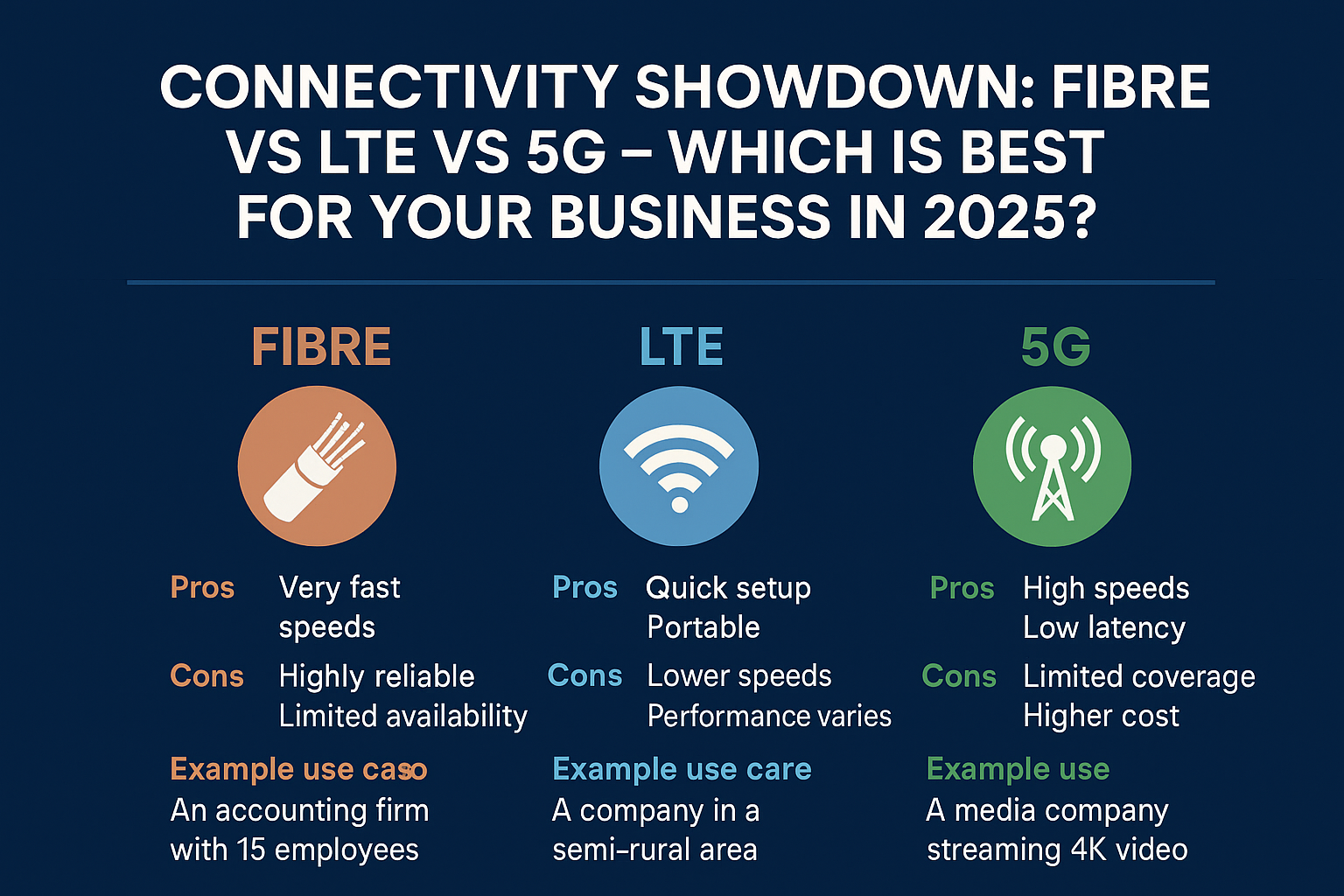
Fibre vs LTE vs 5G: Which Is Best for Your Business in 2025?
Fibre vs LTE vs 5G: Which Is Best for Your Business in 2025?
- June 23 2025
- Best Connected

In 2025, reliable internet is more than a tool, it’s the backbone of every successful business. Whether you're running a startup, managing remote teams, or handling high volumes of online traffic, choosing the right connectivity solution can impact your productivity, customer experience, and long-term growth.
But with multiple options on the table — Fibre, LTE, and 5G — how do you know which one suits your business best?
This buyer’s guide breaks down the pros, cons, and ideal use cases for each, so you can make an informed decision and stay Best Connected.
- Fibre: The Gold Standard for Business
Best For: Established offices, data-heavy environments, VoIP, video conferencing, hybrid work
Pros:
- Lightning-fast speeds (up to 1Gbps+)
- Highly reliable and stable connection
- Symmetrical upload & download speeds
- Ideal for cloud apps, large file transfers, and streaming
- Supports many users at once
Cons:
- Requires physical infrastructure
- Longer installation time
- May not be available in remote areas
Use Case Example:
An accounting firm with 15 employees needing seamless cloud software access, VoIP calls, and large data uploads.
- LTE: Flexible and Fast Setup
Best For: Temporary offices, mobile businesses, rural areas, fast deployment
Pros:
- Quick to install — plug-and-play
- Works in most locations
- Portable and scalable
- Great for backup connectivity
Cons:
- Limited speeds compared to fibre
- Performance may drop in congested areas
- Less reliable during peak hours
Use Case Example:
A small logistics company in a semi-rural area needing fast internet while awaiting fibre installation.
- 5G: The Next-Gen Wireless Power
Best For: Urban SMEs, mobile teams, tech startups, IoT-driven businesses
Pros:
- Ultra-fast speeds (comparable to fibre in some areas)
- Low latency (great for real-time apps)
- No cables – great for mobility
- Expanding coverage in metros
Cons:
- Still rolling out in many parts of SA
- Signal can be affected by buildings or interference
- Costs can be higher initially
Use Case Example:
A media company streaming 4K video and using cloud editing tools on the move, needing speed and flexibility.
Comparison Table
|
Feature |
Fibre |
LTE |
5G |
|
Speed |
★★★★★ (up to 1Gbps) |
★★☆☆☆ (up to 150Mbps) |
★★★★☆ (up to 1Gbps+) |
|
Reliability |
★★★★★ |
★★★☆☆ |
★★★★☆ |
|
Installation Time |
Medium (5–15 days) |
Fast (1–3 days) |
Fast (1–3 days) |
|
Portability |
☆☆☆☆☆ |
★★★★★ |
★★★★☆ |
|
Coverage |
Good (urban/suburban) |
Excellent |
Growing (urban only) |
|
Price |
Medium |
Low |
Medium–High |
Which Should You Choose in 2025?
- Choose Fibre if speed, stability, and scalability are critical for your operations.
- Choose LTE if you need fast setup, portability, or are waiting for fibre.
- Choose 5G if you're in a 5G zone and need mobility with fibre-like speeds.
Pro Tip: Many businesses opt for a dual-connection setup — Fibre as the primary and LTE or 5G as backup — for ultimate uptime.
Conclusion
Every business is different, and so are your connectivity needs. At Best Connected, we help you match the right connection to your growth goals, budget, and location.
Don’t leave your business in the slow lane. Let us help you get connected, stay connected, and grow stronger in 2025.
Need help choosing? Contact Best Connected today for a tailored business connectivity solution.


Leave your thought here
Your email address will not be published. Required fields are marked *